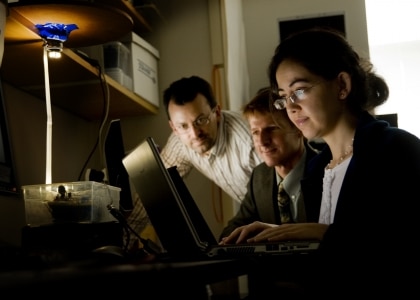Boston University’s College of Engineering is one academic partner launching a major program, under a National Science Foundation (NSF) Grant, to develop the next generation of wireless communications technology based on visible light instead of radio waves. BU researchers (shown at left)expect to piggyback data communications capabilities on low-power, light-emitting diodes (LEDs) to create “Smart Lighting” that would be safer and more secure than current technologies. BU Engineering professor Thomas Little explained, “Imagine if your computer, iPhone, TV, radio, and thermostat could all communicate with you when you walked in a room just by flipping the wall light switch and without the usual cluster of wires. This could be done with an LED-based communications network that also provides light—all over existing power lines with low power consumption, high reliability, and no electromagnetic interference.”The initiative, known as the Smart Lightning Engineering Research Center, is part of an $18.5-million, multi-year NSF program awarded to Boston University, Rensselaer Polytechnic Institute, and the University of New Mexico. BU will focus on developing computer networking applications—viz., the solid state optical technology that will form the network’s backbone. Find the announcement on the BU website. Keep up with the latest news in wireless telecom. Content is updated regularly on Interference Technology’s NEBS/Telecom website.
BU Researchers Working on Light-Based, EMI Immune Wireless Networks





